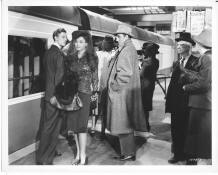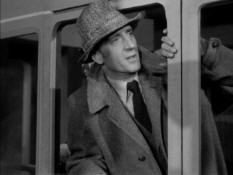Terror
by Night
|
|
"Terror by Night" SHERLOCK HOLMES ADMIRERS ARE OFFERED ANOTHER SUSPENSEFUL MELODRAMA ALL TO THEIR LIKING. Confinement of the action to a train en route from London to Edinburgh, gives the latest of the Sherlock Homes melodramas a compactness that is all to the good. Taking its place among the best of the series, "Terror by Night" enhances its suspense by limiting its locale and acquires a good measure of conviction. It certainly doesn't tax the credulity to the extent that so many of it predecessors in the series have. The picture profits from the restraint exercised in devising its melodramatics. Commanding the interest more than well at all times. "Terror by Night" finds Holmes guarding a priceless gem being conveyed to the home of its owner in Scotland. When the person to whose care the stone has been entrusted is bumped off, the sleuth is confronted with another vexing mystery, which he goes about solving with that efficiency and show of reason characteristic of the man. There is a generous array of suspects, a fact that makes the going so much more interesting and entertaining. Roy William Neill, functioning under Executive Producer Howard Benedict, has produced the film capably and directed it deftly from a Frank Gruber script stemming from a yarn by Sir Arthur Conan Doyle. Basil Rathbone once more is Holmes to the fingertips. Nigel Bruce is amusing as ever as the bumbling Dr. Watson. The villain is smoothly played by Alan Mowbray. The others in the supporting cast are more than adequate. DIRECTION, Good. PHOTOGRAPHY, Good. —The Film Daily, February 4, 1946 |
The serious atmosphere surrounding the murder investigation is lightened by the comic performances of Nigel Bruce (Watson) and Dennis Hoey (Lestrade). When Watson questions Professor Kilbane, Kilbane puts Watson on the defensive by accusing him! When Lady Margaret complains to Holmes and Lestrade that they allowed the Star of Rhodesia to be stolen, she adds, "I intend to report you both to Scotland Yard!" Lestrade sputtered, "But I am Scotland Yard." A short while later Kilbane says to Lestrade, "If you come pounding on my door again, I'll have the law on you." And Lestrade replies, "I am the law."
When Holmes observes Professor Kilbane walking to the end of the carriage, he follows him, and is puzzled that Kilbane has apparently disappeared. At that moment someone pushes him out the door, and very nearly off the train. For several minutes he clings to the outside of the train, and then manages to get back in by breaking the glass in the door.
After this close brush with death, Holmes visits the baggage compartment to examine the coffin. He discovers a secret compartment in the coffin, large enough for a small adult to hide in. Holmes now realizes that Colonel Moran has an accomplice.
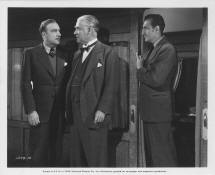 Major Duncan-Bleek, Watson and Holmes |
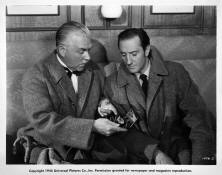 "Great Scot!" Watson and Holmes gawk at the huge diamond. |
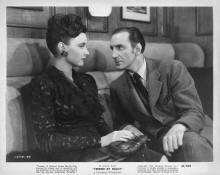 Holmes questions Miss Vedder, a suspicious passenger |
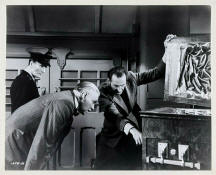 Discovering the secret compartment |
If you haven't seen the film yet, and don't want the mystery spoiled, then read no further!
Lestrade and Holmes question Miss Vedder again, and she admits that she was paid to take the coffin aboard the train. Strangely enough, in the presence of Miss Vedder and Watson's friend Duncan-Bleek, Holmes tells Lestrade that the diamond wasn't stolen. He had switched it with an imitation--the fake was stolen. Holmes had the real diamond in his pocket all along. He gives it to Lestrade for safekeeping. (Watch carefully the scene in which Holmes first inspects the diamond, and you can see his sleight of hand.)
As Holmes and Watson return to the baggage car (and find the baggage guard murdered!), a small, slimy fellow enters Duncan-Bleek's compartment and hands over the diamond, unaware that it is fake. The villain is now revealed to be Duncan-Bleek, and the small man (named Sands) was the one who hid in the bottom of the coffin. After Duncan-Bleek informs him that Lestrade has the real diamond, Sands attacks Lestrade, knocking him unconscious, and then gets the real diamond. Duncan-Bleek takes the diamond and shoots his accomplice, using an air pistol that fires poison darts. The same weapon was used on Carstairs and the baggage guard.
The train comes to a stop and Scottish police board the train. Lestrade is still shaken from his attack, so Holmes and Watson go to talk with Inspector McDonald in the dining car. Holmes informs Inspector McDonald that Duncan-Bleek is really Col. Sebastian Moran. A struggle ensues, the lights go out, but when it's over McDonald and his policemen exit the train with their prisoner. But all is not as it seems. Holmes knew that "McDonald" was not the real Inspector McDonald, and the policemen were not real policemen either. The twist at the end reveals that Holmes still has Col. Moran, now handcuffed, and the diamond aboard the train. The "prisoner" escorted from the train was Lestrade, who now pulls a gun on the fake policemen and arrests them. Amazing that Lestrade figured out the deception that Holmes had planned!
|
"Terror by Night" Another round in Sherlock Homes' unending bout with the masters of the criminal world, one that approaches disaster for the phenomenal detective, Basil Rathbone, "Terror by Night" clings closely to the general pattern of its predecessors. It is good, fairly substantial melodrama, although lacking in originality in story development. Several participants might reasonably be suspected of the initial murder, and other subsequent nefarious doings, as motivated by the coveted Star of Rhodesia diamond—a king-size gem. But Sherlock knows, and it is only a matter of time, and perilous incident, before he outwits the culprit. Nigel Bruce, whose name has become synonymous with Dr. Watson, is again on hand, lending his doubtful assistance, and Allan Mowbray is capable enough as the arch-criminal. Dennis Hoey, Renee Godfrey, Mary Forbes, Billy Bevan and Frederic Worlock are in support. Frank Gruber adapted the Arthur Conan Doyle story, Roy William Neill was producer-director, and Howard Benedict was executive producer. Running time, 60 minutes. General audience classification. Release date, Feb. 2, 1946. —Gene Arneel, Motion Picture Daily, January 28, 1946 |
Terror by Night is not based on a Sherlock Holmes story, but the writers may have been inspired by "The Adventure of the Empty House." Some elements in the film that are also in that story are:
- Colonel Sebastian Moran as the villain;
- the air pistol as the weapon;
- the name Carstairs (In the story it is a place name. Ronald Adair "had been engaged to Miss Edith Woodley, of Carstairs.")
The idea of a secret compartment could be from "The Disappearance of Lady Frances Carfax."
Stock train footage was used in the film, but, as Steinbrenner and Michaels (The Films of Sherlock Holmes, 1978) note, "any reasonably astute train buff can discern they are of wildly differing engine and carriage models!"
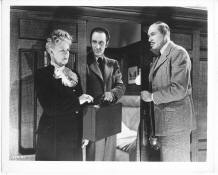 Holmes and Lestrade tell Lady Carstairs that her son has been murdered. |
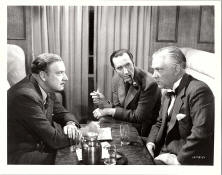 Holmes and Watson talk to Major Duncan-Bleek |
There are a number of unanswered questions in this film. For example, why didn't Watson recognize that Moran was not his old friend Duncan-Bleek? Watson: "I've know him for years; he's a member of my club." And how did Sands get out of Roland Carstairs' locked compartment after murdering him? And remember how Watson and Duncan-Bleek had to run to catch the train in the beginning? When we know that Duncan-Bleek was really Moran, how odd that he would take such a chance on missing the train! What was the point in being so late? But if we refrain from such nitpicking, we can enjoy the fast-paced film and be pleasantly surprised by the plot twists.
Basil Rathbone was under contract to MGM, who loaned him to Universal for this film. Rathbone's salary was $20,000. Nigel Bruce's salary was $15,000.
In his book Sherlock Holmes & the Fabulous Faces, author Michael Hoey tells us that the budget for Terror by Night was $224,725 but the final cost was $251,954, making it the most expensive film in the series. Delays caused by striking studio workers were very likely a contributing factor to the higher production cost. "Production ceased on Terror by Night and Universal's legal department issued a memo to MGM requesting credit on Basil Rathbone's salary for the three lost days." The film was supposed to be shot in 16 days, but it took six days longer.
|
"Terror by Night" with Basil Rathbone and Nigel Bruce A fairly good "Sherlock Holmes" program mystery melodrama. Those who have enjoyed the other pictures in the series will probably enjoy also this one, for the action is pretty exciting and, for the most part, mystifying. Following the formula employed in the previous pictures, Basil Rathbone, as "Holmes," goes about solving the crime in his quiet way, while Nigel Bruce, as "Dr. Watson," his aide, provides occasional bits of comedy by his blustering antics. though far-fetched, the methods "Holmes" employs to outwit the crooks are contrived cleverly. One's interest is held pretty well, for suspicion is directed at several of the characters and it is not until the finish that the guilty person's identity is divulged:— Rathbone and Bruce are hired by Geoffrey Steele to guard a famous jewel that he and his mother were taking to Scotland. Aboard the train, Rathbone meets Inspector Dennis Hoey, of Scotland Yard, who, too, had been delegated to protect the jewel. En route, Steele is murdered mysteriously in his compartment, and the famous gem disappears. Hoey, aided by Rathbone and Bruce, undertakes an investigation and finds reason to suspect among the passengers Frederick Worlock, a professor; Renee Godfrey, a woman of questionable character; and Alan Mowbray, a retired British officer, for whose integrity Bruce vouched, having served with him in India years previously. Carefully sifting his clues, Rathbone comes to the conclusion that Mowbray was actually a notorious international jewel thief, noted for his clever schemes, and that he was implicated in the crime. Upon reaching Edinburgh, the train is boarded by the local police, who, after hearing Rathbone prove that Mowbray had instigated the murder, find the jewel in his possession and arrest him. The jewel thief attempts to escape, but Rathbone, aware that the arresting officers were impostors, part of Mowbray's plan to escape with the gem, subdues Mowbray and through a clever ruse tricks the fake police into taking Inspector Hoey off the train in the belief that they had Mowbray in tow. While Hoey reveals himself on the station platform and arrests the impostors, Rathbone, on the train, handcuffs Mowbray and discloses to Bruce that the real diamond had always been in his possession since he had substituted a fake one in its place. Frank Gruber wrote the screen play, and Roy William Neill produced and directed it. Unobjectionable morally. —Harrison's Reports, January 26, 1946 |
Terror by Night trivia:
- It is the shortest of the 14 Sherlock Holmes films with Rathbone and Bruce;
- It was Dennis Hoey's final appearance as Lestrade; and
- Alan Mowbray (Duncan-Bleek) played Lestrade in the 1933 film A Study in Scarlet.
Watch the trailer for Terror by Night:
See more photos and reviews on page 2.
See Posters, Lobby Cards and Promo Photos on page 3.
.
|
.
|
|
Terror by Night is available |
DVD also available as part of The
Sherlock Holmes Collection, Volume 3: |
Note: Terror by Night is one of the four Sherlock Holmes films that is in the public domain. That means that anyone can legally produce and sell a DVD of this film. Consequently, it's easy to find cheap DVDs of Terror by Night. But these cheap ones are also cheap quality. The links above are for the digitally remastered, high-quality DVDs produced by MPI Home Video. Don't waste your money on anything else!







